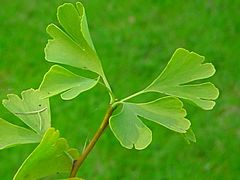Ginkgo facts for kids
Quick facts for kids Ginkgo |
|
|---|---|
 |
|
| Ginkgo leaves | |
| Conservation status | |
| Scientific classification | |
| Kingdom: | |
| Division: |
Ginkgophyta
|
| Class: |
Ginkgoopsida
|
| Order: |
Ginkgoales
|
| Family: |
Ginkgoaceae
|
| Genus: |
Ginkgo
|
The ginkgo is a very special kind of tree. It is often called a "living fossil." This is because it looks almost exactly like its ancient relatives from millions of years ago! Today, there is only one type of ginkgo tree still alive. It is called Ginkgo biloba. All other ginkgo types are only found as fossils. The Ginkgo biloba tree originally comes from China. It is even the official National tree of China.
Contents
What Makes Ginkgo Special?
The ginkgo tree is unique in many ways. It is the only living member of its entire plant group. This group is called Ginkgophyta. It has survived for an incredibly long time. Scientists believe ginkgo trees have been around for over 200 million years!
Leaves That Stand Out
Ginkgo leaves are easy to spot. They have a fan shape, almost like a small hand fan. The leaves usually have a split down the middle. In autumn, they turn a beautiful bright yellow color. Then they fall off quickly, often all at once.
Tough and Resilient Trees
Ginkgo trees are very strong. They can live for thousands of years. Some ginkgo trees in China are thought to be over 1,500 years old! They can also survive in tough conditions. They are resistant to many plant diseases and insects. They can even grow well in cities, handling pollution.
Where Do Ginkgo Trees Grow?
While ginkgo trees are native to China, they are now planted all over the world. You can find them in parks and along streets in many countries. They are popular because they are beautiful and hardy.
-
A ginkgo tree in Slovakia
How Ginkgo Trees Reproduce
Ginkgo trees have a unique way of making new trees. Unlike many plants, male and female parts are on separate trees. This means you need both a male and a female tree for reproduction to happen.
Male and Female Trees
Male ginkgo trees produce small pollen cones. These cones release pollen into the air. Female ginkgo trees produce small structures that will become seeds. The wind carries pollen from male trees to female trees.
Ginkgo Seeds
After pollination, the female tree produces seeds. These seeds look a bit like small yellow plums. They have a fleshy outer layer. When this layer breaks down, it can smell quite strong. Because of this smell, female ginkgo trees are often not planted in public places. The inner part of the seed is edible after being cooked. It is a traditional food in some parts of Asia.
Ginkgo in History and Culture
Ginkgo trees have a long history with humans. They have been grown in Chinese and Japanese temples for centuries. They are seen as symbols of hope and peace.
A Symbol of Survival
Ginkgo trees are known for their incredible ability to survive. After the atomic bomb in Hiroshima, Japan, in 1945, several ginkgo trees were among the few living things to survive close to the blast site. They quickly regrew, showing their amazing strength. This made them even more respected as symbols of endurance.
Images for kids
See also
 In Spanish: Ginkgo para niños
In Spanish: Ginkgo para niños







